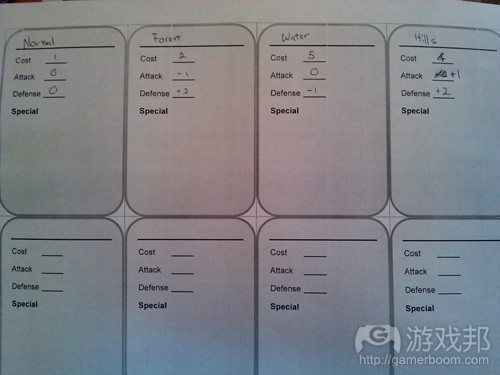分享创建低保真度游戏原型以测试游戏的经验
作者:Chris Khoo
当我们最初开始开发游戏时,我们希望游戏既能够吸引休闲策略型玩家的注意,也能够拥有足够的策略深度而满足硬核游戏玩家的需求。但是在过去几周的时间里我们突然恍悟到,虽然我们创造了一款具有深度的策略型游戏,但是却带给了玩家一种乏味的互动体验。
所以我们有必要尽快解决这一问题。
从表面看来,我们所面临的最大障碍便是累赘的用户界面。虽然UI突出了大量的策略命令选项,但即使是最普通的任务也要求玩家至少点击3次才能够完成。不管怎样,UI的复杂度只是过于复杂的游戏设计的外在表现——虽然在游戏中的任何时刻都存在各种各样的命令,但是大多数命令却是不常出现的(游戏邦注:也就是玩家很少能够真正使用到),或者只具有糟糕的互动作用。
我真的是无意设计出这款复杂的游戏,并且直到4个月之后我才发现了问题所在——一切的一切都是因为我始终说服自己应该快速创建游戏的技术原型而不是“浪费时间”创造纸质原型。
所以这一次我决定不再重蹈覆辙了。我花费了1周的时间想出了核心活动的设计理念,随后我开始使用我的桌面游戏收集物中的游戏组件,以及来自于一元店的代币和计数器组件等创造一个低保真度的游戏原型(如下图所示):
而最终结果也正如我的预想中那样。
在不到一天时间内我便将核心活动转变成了桌面游戏的相等内容。随后,我和搭档又花了4天的时间在测试并完善这一核心活动。在游戏测试的最后,我的商业合作伙伴也明确了我们所创造的内容,并且我也能够通过一系列清晰的数据证明游戏的复杂度问题彻底得到的了解决,且未牺牲任何策略深度——所以我们重拾了信心,并证明了我们的游戏拥有绝对的发展潜力。
总之,我发现在大多数回合制游戏中,比起建造技术原型,基于桌面游戏创建原型更加省事且更有效率。也就是如果创建桌面游戏原型已经够复杂了,那么创建技术原型就更不用说了。除此之外,创建桌面游戏原型的复杂性也就意味着你的游戏设计可能会面临过于复杂的危险,或者你还未仔细审视游戏设计中的相关细节。这也说明你需要更加深入地重新审视自己的游戏设计。
(这是我们的其中一次测试。我们使用了彩色计数器组件去代表不同的地形。)
(我使用了升级后的MS Word 2010纸牌游戏模版去创建所有的纸牌,包括这些代表地形属性的纸牌。)
(本文为游戏邦/gamerboom.com编译,拒绝任何不保留版权的转载,如需转载请联系:游戏邦)
Play testing a game design the low fidelity way
by Chris Khoo
When we first started developing the title, our aspiration was to build a game which casual strategy fans could easily pick up, but with enough strategic depth to satisfy the more hardcore strategist. Over the past few weeks, it became clear that we had built a satisfyingly deep strategic experience, but interacting with the game felt tedious Panic.
Once the butterflies in my stomach had settled, it was time to look deeper into the issue.
On the surface, the biggest hurdle was the cumbersome user interface. The UI featured plenty of strategic command options but the most common tasks required at least 3 clicks to complete. However, the UI’s complexity was just the outward manifestation of the over complicated game design – there were too many commands available to a user at any one point in time, but most of the commands were infrequently used ones, or just badly thought out interactions.
I had inadvertently designed a complicated game and I had not discovered my mistake until 4 months down the road – all because I had convinced myself early on that it was faster to build the tech prototype rather than ‘waste time’ building a pen-and-paper version.
The game design was in need of some major work (for the third time).
This time, I was determined not to repeat my earlier mistake. After spending a week coming up with a core activity re-design, I started building a low fidelity prototype using game pieces from my board games collection, and some additional counters and tokens from the corner dollar store.
I used components from the ‘Halo’ boardgame along with some dice and counters from the dollar store
The results were extremely positive.
I translated the core activity into a board game equivalent in less than a day. My partner and I then spend a total of 4 days play testing and refining the core activity. At the end of the play tests, my business partner had a clear idea what it was that we were building, I had a clear data suggesting that the game complexity problem had been resolved without compromising strategic depth (much), and we both had renewed confidence that the game had strong potential.
The first low-fidelity game prototype I built
My second low-fidelity game prototype (2 days later)
In conclusion, I’ve learnt that most turn-based game designs are faster prototyped as a board game rather than as a tech prototype. If it’s arduous building the board game prototype, building the tech prototype is bound to be worse. In addition, the difficulty in building a board game prototype may indicate a significant risk that that the design is too complex or that the design details may not have been fully thought out. In either case, it’s a clear signal that the game design needs to be scrutinized deeper.
One of our playtests in progress. We used coloured counters to represent different terrain types
I used a modified MS Word 2010 card game template to build all the cards including these terrain stats ‘cards’
(source:GAMASUTRA)












































 闽公网安备35020302001549号
闽公网安备35020302001549号